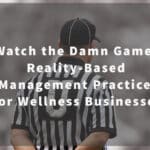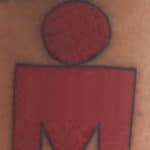We’ve worked recently with three wellness businesses that spend heavily on booths at women’s expos, health fairs, and other consumer wellness events.
None of them are happy with the results. They make very few sales at the actual events. And hardly any of the people who stop by their booths and grab the freebies and giveaways turn into paying customers down the road.
What are they doing wrong?
The key point to remember is that marketing is a process, not a one-time event.
Prospects – potential customers — don’t usually buy based on a single exposure to your business. That’s one of the reasons that one-shot direct mail campaigns and newspaper ads don’t work well.
You’re doomed to disappointment if you expect to make lots of sales or get lots of hot leads at the typical health fair or wellness expo. Health fairs and expos cannot be your only — or even your primary — marketing focus if you want to profitably grow your business.
Effective marketing consists of an ongoing series of planned communications. Your booth at the expo or health fair is just one small piece in a much bigger marketing picture.
What makes expo & health fair investments pay off?
The real purpose of a wellness expo or similar consumer event is to:
- Collect contact information for prospective customers and
- Get their permission to communicate with them in the future.
That’s all. The purpose of a health fair or expo isn’t to blast prospects with your sales pitch. And it’s usually unrealistic to think that you’re going to be busy taking orders from new customers, too.
Once you’ve got their contact info, your next step is to feed those prospects into your “marketing machine” — your series of planned communications.
If you haven’t created your own “marketing machine”, you’re probably wasting your time and money at expos and health fairs. There’s no point in attending unless you know what you’re going to do with the leads you collect.
How do we know what our “marketing machine” should look like?
Effective marketing consists of an ongoing series of planned communications with your potential customers. That’s why we mean by your “marketing machine”.
You need a mixture of marketing tactics, because not all of your potential clients are at the same point in the buying process.
Let’s use prospects who want to lose weight as an example. Some are just starting to think about whether they need and want to lose weight. Others are ready to get started. And others are considering their options – Weight Watchers, a health-club weight loss program, the South Beach Diet book, or portion-controlled frozen dinners.
To figure out the components of your marketing machine:
1. Describe the typical buying journey for your prospective customers.
2. Identify typical concerns of prospective customers at each stage in that journey.
3. Identify typical actions that they take to address their concerns at each stage.
4. Identify marketing tactics tailored to each stage.
For example, here’s a typical buying journey for a prospective weight loss customer:
|
Stage In Buying Journey |
Typical Prospect’s Concerns & Actions |
Sample Marketing Activities Communications |
| 1) Becomes unhappy about her weight | Feels resignedAvoids clothes-shopping and special occasions | Awareness seminars that losing weight can be done gradually and without misery |
| 2) Has need or desire to take action | Starts avoiding sugary sodas & snacksThinks about going for walks at lunch | Free educational brochures at health fairs and wellness expos |
| 3) Identifies alternatives | Wonders about all the possibilitiesAsks friends and family what’s worked for themDoes Internet research on diet aids, weight loss plans, etc.
Glances at supermarket magazines & diet books Asks people she knows in healthcare professions for suggestions |
Case studies demonstrating how your program or service really works for a typical clientReferral incentives for your current clientsQuarterly newsletter featuring customer success stories |
| 4) Compares alternatives to likely results | Asks friends and family what’s worked for themDoes more Internet researchReads fitness and diet books more closely
Asks people she knows in healthcare professions for suggestions |
Side-by-side comparisons of optionsComparison of financial and emotional cost to financial and psychological benefits |
| 5) Decides which alternative best suits her | Considers her budget, personal likes & dislikes, her history of what’s worked and what hasn’t and more | Testimonials and customer referencesPrice listsAvailable features and options |
| 6) Justifies her decision | Shares her plan with friends to get their reaction, justifies it in terms of money she’ll save on bigger clothes, etc. | Sales tools where prospects identify top 10 reasons for wanting to lose weightWW-style “never again” list |
| 7) Actually buys weight loss product or service | Wants reassurance that if it doesn’t work, she’s protected | 30-day guaranteeFree session offer |
| 8) Starts using products or services she just bought | Wants early indications that she’s going to get the results she’s hoping for | Set expectations early to avoid disappointmentCheck in with new clients during first couple of weeksDesign program to produce small but visible early wins |
Do customers really think this way?
Yes and no.
In reality, many potential customers move back and forth between these stages until they’re ready to buy. And the amount of time they spend in a particular stage varies by person as well. While they may not move neatly and quickly from stage to stage, every customer eventually moves through all of these stages – even though they may spend weeks, months or years in some stages, and mere minutes in others!
For example, our hypothetical customer might spend several months thinking about taking action without actually doing more than avoiding sugary sodas and potato chips. She might think about walking at lunch – but always defer it to another day when she’s not so busy.
Someone else might decide that she’s simply going to log her food (Stage 4) in a notebook — after all, it’s easy to get started and it won’t cost her anything. After a couple of weeks of logging, if she’s not happy with her results, she might jump right into signing up with a weight loss program (Stage 6), based on information she gathered leading up to her initial decision to log her food.
And someone else might sign up for a weight loss program, attend the first couple of meetings, and then drop out, deciding that she’s actually OK with weighing 10 pounds more than she did when she got married. A year later, she may start the buying process again as her high school reunion approaches.
What mistakes should we avoid in designing our “marketing machine”?
1) Designing marketing activities or marketing materials for just one or two stages of your customer’s buying process.
You need to market to prospective customers at every stage of the process.
For example, we’ve worked with many clients whose marketing materials consisted only of a price list. However, price lists are most useful late in the buying process. A side-by-side comparison of alternatives would have been very helpful to get prospects to favor their services in the first place. A free seminar on “Weight Loss Without Misery” would be a great way to get the attention of folks at the very beginning of the buying process.
We’re not crazy about health fairs and wellness expos as marketing investments. However, if you’re going to participate, realize that they usually attract prospects in the early stages of the buying process. They’re most suitable for raising awareness about problems. For example, you can hand out free educational material. But as the chart above demonstrates, raising awareness is a long way away from actually making a sale.
2) Planning marketing activities and materials for the very beginning and the very end of the buying process — with nothing in the middle to aid the prospect in making a decision that favors your wellness business.
It’s fine to start with an educational brochure and a list of your weight management services and prices.
But then you need to develop the rest of your “marketing machine.”
For example, provide side-by-side comparisons of your services versus the alternatives, testimonials from happy customers, and case studies to show exactly what a potential customer could expect to experience. Consider adding a one-pager that compares the cost of your service to the cost of buying larger sizes, or buying special foods, or the wonderful way you’ll feel at your reunion.
Bottom line, your marketing activities and materials for the middle stages need to help customers realize that you’re the best option available to them, and why.




